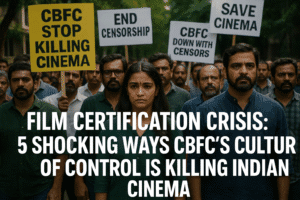Film Certification Crisis: 5 Shocking Ways CBFC’s Culture of Control is Killing Indian Cinema
Filmmakers in Kerala recently protested outside the CBFC office against the board’s demand to rename the protagonist in “Janaki vs State of Kerala” – an assault survivor – deeming her divine-name association inappropriate. This incident underscores a troubling pattern: films like Diljit Dosanjh’s long-delayed “Punjab 95,” “Nasir,” and “Santhosh” face indefinite holds or forced edits, revealing the CBFC’s shift from certification to active censorship.
These targeted films consistently challenge sensitive narratives around caste oppression, state power, or religious orthodoxy. The board’s arbitrary cuts and delays create a profound chilling effect, pushing creators toward self-censorship to avoid political or bureaucratic backlash. This stifling environment prioritizes sanitized storytelling over artistic integrity, economically cripples independent voices, and ultimately narrows the vital cultural dialogue Indian cinema has historically fostered. The true cost is the erosion of diverse, critical storytelling itself.

Film Certification Crisis: 5 Shocking Ways CBFC’s Culture of Control is Killing Indian Cinema
The scene outside the CBFC office in Thiruvananthapuram wasn’t a movie premiere. It was a protest. Filmmakers, actors, and technicians from the Malayalam industry stood united, their placards not celebrating cinema, but decrying its slow suffocation. The immediate catalyst was “Janaki vs State of Kerala,” a film about an assault survivor. The CBFC didn’t object to the story’s sensitivity or its portrayal of trauma. Instead, they demanded the character’s name be changed. Why? Because “Janaki” is an epithet for the Hindu goddess Sita. The board decreed a survivor could not bear a “divine” name.
The irony was palpable. Union Minister Suresh Gopi, a prominent figure in the ruling establishment, starred in the film. Yet, even political clout couldn’t shield this story from the censors’ arbitrary blade.
This isn’t an isolated incident. It’s a pattern revealing a profound shift in how India regulates its stories:
- “Punjab 95”, Diljit Dosanjh’s powerful portrayal of human rights during Punjab’s turbulent past, has languished in CBFC limbo for over two and a half years. Its historical narrative remains unseen by the public.
- “Nasir” (Tamil), exploring complex social realities, and “Santhosh” (Hindi), reportedly examining systemic issues, join the list of films denied release certificates or subjected to paralyzing delays.
The CBFC may be named the Central Board of Film Certification, but its actions increasingly mirror those of a censorship bureau. The distinction is crucial, and it’s being erased. Certification implies evaluating content for appropriate audience viewing (like age ratings). Censorship involves altering or suppressing content deemed politically inconvenient, culturally offensive, or religiously sensitive by those in power.
The Uncomfortable Truths Facing the Scissors: The common thread binding “Janaki,” “Punjab 95,” “Nasir,” and “Santhosh” isn’t poor quality; it’s their engagement with themes that make established power structures uneasy:
- Challenging Caste: Stories exposing the enduring brutality and injustice of the caste system.
- Questioning State Power: Narratives examining state violence, historical grievances, or governmental overreach.
- Interrogating Religious Ideas: Depictions that portray religious figures or concepts in complex, human contexts, rather than purely divine or idealized ones.
The Chilling Effect: When Scissors Become Invisible
The most insidious consequence isn’t just the visible cuts or outright bans. It’s the pervasive chill that settles over the creative landscape:
- Self-Censorship Takes Root: Filmmakers, writers, and producers start asking themselves before a script is even written: “Will the CBFC pass this?” “Is this character’s name too risky?” “Is this historical period too controversial?” This internal filtering kills stories in their infancy, long before they reach an official censor.
- Economic Strangulation: Independent producers, operating on tight budgets, simply cannot afford years of legal battles or indefinite delays. Financially risky, critical narratives become commercially unviable. Safe, formulaic content thrives.
- Erosion of Trust: When a certification body acts unpredictably, applying opaque moral or political standards instead of transparent guidelines, filmmakers lose faith in the system. The process feels less like regulation and more like intimidation.
- A Narrowed Cultural Mirror: Cinema reflects society, warts and all. When stories about caste oppression, state accountability, or complex religious identities are systematically muted or distorted, the reflection India sees of itself becomes sanitized and incomplete. We lose the capacity for difficult conversations and critical self-examination.
The Real Cost: More Than Just Minutes on the Cutting Room Floor
The stakes are higher than individual films. This trend represents a fundamental shift in the relationship between creative expression and state authority in India. When a film about a survivor named Janaki is deemed offensive not for its content, but for its name, it signals a profound discomfort with artistic autonomy and the messy realities of Indian life.
The protest in Thiruvananthapuram is a symptom of a deeper anxiety: Is India’s vibrant cinematic tradition, long a space for powerful social commentary and dissent, being quietly reshaped into an echo chamber, where only stories that fit comfortably within prescribed political, cultural, and moral lines are allowed to speak? The chilling reality of self-censorship suggests the answer, for now, is leaning disturbingly towards yes. The true cost is measured not just in delayed releases, but in the stories we will never get to see, and the conversations we will never get to have.
You must be logged in to post a comment.